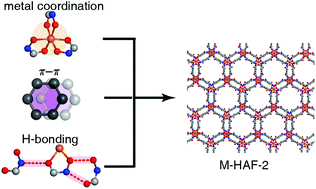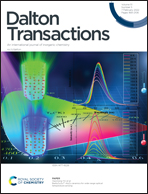Metal-hydrogen-pi-bonded organic frameworks†
Abstract
We report the synthesis and characterization of a new series of permanently porous, three-dimensional metal–organic frameworks (MOFs), M-HAF-2 (M = Fe, Ga, or In), constructed from tetratopic, hydroxamate-based, chelating linkers. The structure of M-HAF-2 was determined by three-dimensional electron diffraction (3D ED), revealing a unique interpenetrated hcb-a net topology. This unusual topology is enabled by the presence of free hydroxamic acid groups, which lead to the formation of a diverse network of cooperative interactions comprising metal–hydroxamate coordination interactions at single metal nodes, staggered π–π interactions between linkers, and H-bonding interactions between metal-coordinated and free hydroxamate groups. Such extensive, multimodal interconnectivity is reminiscent of the complex, noncovalent interaction networks of proteins and endows M-HAF-2 frameworks with high thermal and chemical stability and allows them to readily undergo postsynthetic metal ion exchange (PSE) between trivalent metal ions. We demonstrate that M-HAF-2 can serve as versatile porous materials for ionic separations, aided by one-dimensional channels lined by continuously π-stacked aromatic groups and H-bonding hydroxamate functionalities. As an addition to the small group of hydroxamic acid-based MOFs, M-HAF-2 represents a structural merger between MOFs and hydrogen-bonded organic frameworks (HOFs) and illustrates the utility of non-canonical metal-coordinating functionalities in the discovery of new bonding and topological patterns in reticular materials.



 Please wait while we load your content...
Please wait while we load your content...